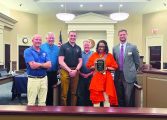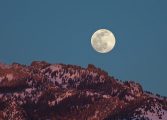By Page H. Gifford
Correspondent

Landscape and wildlife photographer Ben Greenberg will talk to Friends of the Library about his work on May 1 at 10 a.m.. Greenberg’s vibrant photos of his subjects capture a single element of natural beauty that attracts the viewer, from his weeping landscapes to his majestic birds.
From an early age he spent most of his time outdoors but after his first son Jeff was born, he became seriously interested in photography.
“It did not take me long to realize that my camera gave me wonderful opportunities to explore the natural world and capture photographs that provided a way to connect to that world in a very personal and meaningful manner.”
He added that his connections to the natural world with his camera were part of his overall approach to professional and personal photography. There were opportunities during that time that helped him to realize how much he enjoyed photographing that world, including the time in 1984 when he spent several days on the California coast or how his experiences intensified in 1998 when he spent two and one-half weeks photographing the coast of Maine. “I realized how much I loved photographing the natural world and how much I wanted to commit my future photography to that alone. Since that time, I have done just that.”
As he became more committed to photographing the natural world, “I became aware of the potential natural beauty that was available to photograph virtually everywhere.
“I was most familiar with the potential to photograph Virginia but it did not take me long to realize that my knowledge of Virginia was more limited than I realized. That was also true concerning the natural beauty that was available throughout our country.”
First, he began searching for photographic opportunities in Virginia and was particularly attracted to the public lands. He then sought out ways to become familiar with photographic opportunities throughout the United States. He began collecting books, maps, and materials that would help educate him regarding the natural wonders available to photograph. He also started a library of great work by photographers whose images impressed him. “The more I exposed myself to such information, the more I was inspired to expand my photography in Virginia and throughout the country.”
“I am a firm believer that the composition of a photograph is the most difficult aspect of photography to learn and master. I have a secret to making that process easier. I have studied and admired great photographs of great photographers for many years and this process has helped me understand principles of composition that have guided me ever since.”
“Mastering photography involves mastering numerous techniques that are critical to the success of an image. While there are many that I could cite, there is one principle that applies to both landscapes and wildlife that is essential for a quality image. That principle is that the image must be sharp. In the landscape photograph, I typically want everything in the image to be sharp.” Anyone familiar with photographic techniques and jargon understands Greenberg’s sharp-focus achievement with a tripod, low ISO (film speed) a small aperture (f-stop) for great depth, and a fast enough shutter speed to stop any movement in the scene. “These techniques and the need for a very sharp image cannot be emphasized enough. I want to achieve the capability of enlarging my images as large as possible and with these techniques, I can do so beyond my wildest dreams. There is nothing quite like seeing an image, especially a panorama, blown up five or six feet wide.”
He uses this same technique when photographing wildlife but adds It can be more difficult to capture a sharp wildlife photograph due to the movement of wildlife.
“That movement can be addressed with a fast enough camera shutter speed, which a good friend taught me could require a shutter speed of 1/1500 of a second or even faster. It is also important to point out that the eyes of wildlife must be sharp if the wildlife photograph is to be considered sharp,” he said. “The focus point to be placed carefully on the eye or head of the wildlife. One of my favorite wildlife photographs is of a fox running through wildflowers near Glacier National Park. I cannot tell you how pleased I was when I was able to capture an image in which every hair on the body of the fox was sharp despite his speedy movement thanks to my shutter speed of 1/2000 of a second.”
Photographers learn to chase the light and capture the moment.
“My favorite photograph of the natural world involves both a magnificent landscape and the challenge of capturing an important wildlife image.” He explained that he once lived on Riverside Drive on the south side of the James River in Richmond. He lived a mile away from the Pony Pasture area of the river. He arrived one morning early when it was still dark and used a flashlight to find his way to the edge of the river where he set up my camera and tripod facing the direction where the sun would come up. It took a while but to his surprise on a ledge of the river directly in front of him was a majestic great blue heron walking back and forth. It was apparent that he was searching for his early morning meal.
“The light was still too dim to capture a quality photograph, especially with the great blue heron in constant movement on the ledge,” he said. “After waiting an agonizing amount of time for the light to improve, I started shooting photographs in the hope that I would capture an image that would reflect how I felt about the amazing scene that was playing out in front of me.” He shot all 21 photographs of the heron on his roll of film with no idea of whether he got an image that would be as good as I hoped. As he went through the 21 photographs, it wasn’t until he until last photograph on the roll that his intention was realized. “While the image would have been exciting enough by itself, the fact that it has been my favorite and best-selling photograph as well as the image on the cover of my first photography book, Natural Virginia, makes it even more memorable for me.”
He says creativity comes from his hard work. An interesting concept.
“The harder I work, the luckier I get. It takes hard work to become knowledgeable regarding your subject, to put yourself in locations at times when the light can be magical, and to be able to recognize how to achieve quality images of subjects that can truly move others. My creativity comes from my desire to present a subject in its best form and best light possible. I believe that best reflects the essence of a subject, whether it be a landscape or wildlife. That is how I am true to a subject and its true nature.”
For more information about this upcoming event, contact the Fluvanna County Public Library at https://www2.youseemore.com/fluvanna/.




